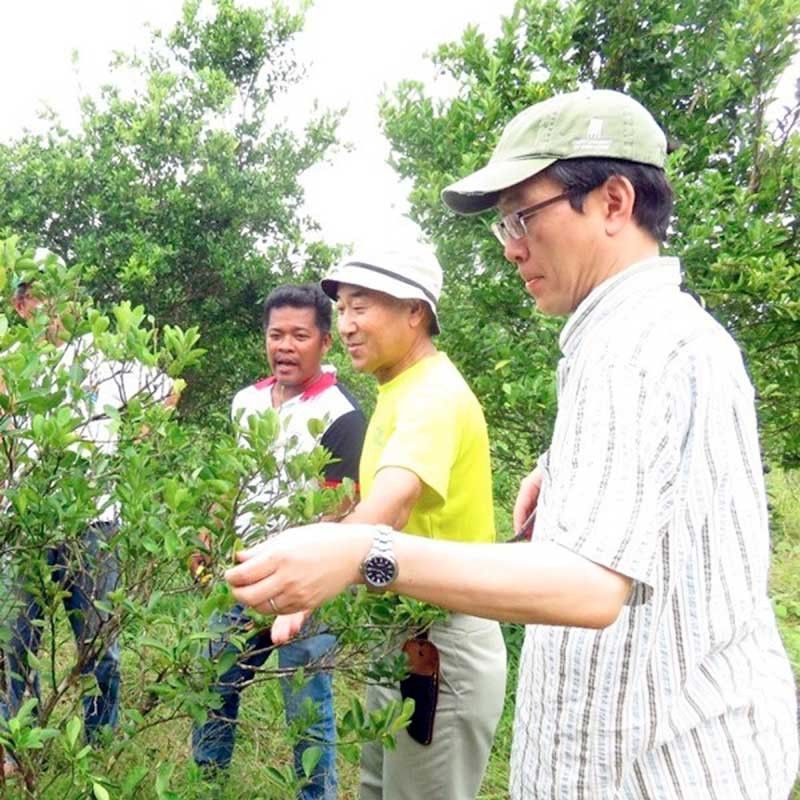Calamansi gets boost with new technology for off-season harvest

MANILA, Philippines — The Tokyo University of Agriculture (Tokyo NODAI) has introduced the off-season production of calamansi in Victoria, Oriental Mindoro to help boost Philippine calamansi output and exports.
The Japanese team has employed a new technology on pruning to delay the harvest of calamansi in order to keep the bounty all year long. This will allow farmers to enjoy a higher income from the high value crop.
It also raises the potential to expand the Philippines’ yearly exports of around 170 metric tons (MT) of fresh and processed calamansi to Hong Kong, Saudi Arabia and the United Arab Emirates.
The Mindoro State College of Agriculture and Technology, led by its vice president Ma. Conception Mores, coordinated with Tokyo NODAI to identify farm sites for the continuous trial on the off season calamansi technology.
“The success of these farming technologies in attaining a stable supply of calamansi even during lean months will bring farmers in a better position where they can maximize the economic benefits brought about by higher level of farm gate prices, which in turn raise farm income,” said Patricia Ann Pielago of the South East Asian Regional Center for Graduate Study & Research in Agriculture (SEARCA).
Basal application of fertilizer solutions using abscissic acid and Miyobi Gold, a commercial fertilizer in Japan containing natural type of ABA and potassium, were done to promote and increase flower formation during off-season.
The two-hectare calamansi demonstration farm owned by calamansi grower Cornelio Palomar in Bgy. Leido, Victoria was the chosen experimental site considering the age (six years) and height (one to 2.5 meters) of trees. These fit the required tree characteristics for each treatment.
A total of 30 calamansi trees were selected, tagged and weeded.
A quarter of a kilogram of fruit samples for each of the four maturity stages of calamansi (mature green, breaker, ripe and over-ripe) were gathered for laboratory analysis to determine the physio-chemical characteristics. That includes ascorbic acid content as part of the fruit quality evaluation.
The project may include the export of processed calamansi like puree and juice.
Tokyo NODAI agreed to replicate its previous joint study on calamansi with the University of the Philippines Los Baños-Post Harvest Technology Research in Mindoro. There will be a systematic way of monitoring, data collection, and proper documentation to analyze the technology’s efficacy.
Philippine calamansi exports ranged from 20 to 35 MT in 2008 to 2013 with an average yearly export of 29.5 MT.
Among the factors that have stunted the calamansi sector’s growth are lack of good-quality calamansi seedlings, high incidence of pests and diseases, declining volume of production, huge post-harvest losses, limited access to market, inconsistent quality of processed calamansi products and low prices during peak season.
Lack of resources, skills, knowledge, and experience in collective marketing among calamansi farmers was also a factor.
The largest production of calamansi is in Victoria, Oriental Mindoro.
According to the Department of Agriculture-Philippine Rural Development Program, buyers prefer calamansi from Oriental Mindoro because it has a thicker rind, stronger taste, longer shelf-life, and resists weight loss.
Production had declined over a six-year period from 199,675 MT over a land area of 20,956 hectares in 2008 to 164,050 MT over a land area of 20,246 hectares in 2013.
The decline was due to the greening disease or ”huanglubin’ which decreases yield and causes death of trees, the Food and Fertilizer Technology Center said.
Calamansi is produced primarily from MIMAROPA (Mindoro, Marinduque, Romblom, Palawan 6,872 hectares), Central Luzon (Zambales, Bulacan, Pampanga, Nueva Ecija, Bataan 1,734 ha) and Ilocos Region (1,026vha) in Luzon.
In Mindanao, producers are in Davao (1,797 hectares), CARAGA (1,412 hectares) and Zamboanga Peninsula (1,077 hectares).
Yield has been dropping from an average of 9.53 MT hectares in 2008 to 8.10 MT in 2013.
With lower production, prices have increased from only P13.28 per kilo in 2008 to P23.13 per kilo.
- Latest


























